
Rodhocetus is an extinct genus of protocetid early whale known from the Lutetian of Pakistan. The best-known protocetid, Rodhocetus is known from two partial skeletons that taken together give a complete image of an Eocene whale that had short limbs with long hands and feet that were probably webbed and a sacrum that was immobile with four partially fused sacral vertebrae. It is one of several extinct whale genera that possess land mammal characteristics, thus demonstrating the evolutionary transition from land to sea.
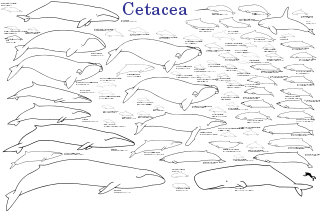
The evolution of cetaceans is thought to have begun in the Indian subcontinent from even-toed ungulates (Artiodactyla) 50 million years ago (mya) and to have proceeded over a period of at least 15 million years. Cetaceans are fully aquatic mammals belonging to the order Artiodactyla and branched off from other artiodactyls around 50 mya. Cetaceans are thought to have evolved during the Eocene, the second epoch of the present-extending Cenozoic Era. Molecular and morphological analyses suggest Cetacea share a relatively recent closest common ancestor with hippopotami and that they are sister groups. Being mammals, they surface to breathe air; they have five finger bones (even-toed) in their fins; they nurse their young; and, despite their fully aquatic life style, they retain many skeletal features from their terrestrial ancestors. Research conducted in the late 1970s in Pakistan revealed several stages in the transition of cetaceans from land to sea.

Ambulocetus is a genus of early amphibious cetacean from the Kuldana Formation in Pakistan, roughly 48 or 47 million years ago during the Early Eocene (Lutetian). It contains one species, Ambulocetus natans, known solely from a near-complete skeleton. Ambulocetus is among the best-studied of Eocene cetaceans, and serves as an instrumental find in the study of cetacean evolution and their transition from land to sea, as it was the first cetacean discovered to preserve a suite of adaptations consistent with an amphibious lifestyle. Ambulocetus is classified in the group Archaeoceti—the ancient forerunners of modern cetaceans whose members span the transition from land to sea—and in the family Ambulocetidae, which includes Himalayacetus and Gandakasia.
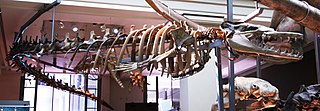
Basilosaurus is a genus of large, predatory, prehistoric archaeocete whale from the late Eocene, approximately 41.3 to 33.9 million years ago (mya). First described in 1834, it was the first archaeocete and prehistoric whale known to science. Fossils attributed to the type species B. cetoides were discovered in the United States. They were originally thought to be of a giant reptile, hence the suffix "-saurus", Ancient Greek for "lizard". The animal was later found to be an early marine mammal, prompting attempts at renaming the creature, which failed as the rules of zoological nomenclature dictate using the original name given. Fossils were later found of the second species, B. isis, in 1904 in Egypt, Western Sahara, Morocco, Jordan, Tunisia, and Pakistan. Fossils have also been unearthed in the southeastern United States and Peru.
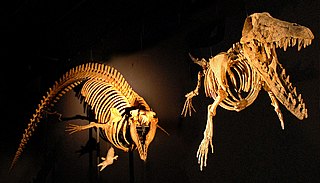
Archaeoceti, or Zeuglodontes in older literature, is a paraphyletic group of primitive cetaceans that lived from the Early Eocene to the late Oligocene. Representing the earliest cetacean radiation, they include the initial amphibious stages in cetacean evolution, thus are the ancestors of both modern cetacean suborders, Mysticeti and Odontoceti. This initial diversification occurred in the shallow waters that separated India and Asia 53 to 45 mya, resulting in some 30 species adapted to a fully oceanic life. Echolocation and filter-feeding evolved during a second radiation 36 to 35 mya.

Protocetus atavus is an extinct species of primitive cetacean from Egypt. It lived during the middle Eocene period 45 million years ago. The first discovered protocetid, Protocetus atavus was described by Fraas 1904 based on a cranium and a number of associated vertebrae and ribs found in middle Lutetian Tethyan marine limestone from Gebel Mokattam near Cairo, Egypt.

Janjucetus is an extinct genus of cetacean, and a basal baleen whale (Mysticeti), from the Late Oligocene around 25 million years ago (mya) off south-east Australia, containing one species J. hunderi. Unlike modern mysticetes, it possessed large teeth for gripping and shredding prey, and lacked baleen, and so was likely to have been a predator that captured large single prey animals rather than filter feeding. However, its teeth may have interlocked, much like those of the modern-day filter-feeding crabeater seal, which would have allowed some filter-feeding behaviour. Its hunting behaviour was probably similar to the modern-day leopard seal, probably eating large fish. Like baleen whales, Janjucetus could not echolocate; however, it did have unusually large eyes, and so probably had an acute sense of vision. The only specimen was found on the Jan Juc beach, where the remains of the extinct whales Mammalodon, Prosqualodon and Waipatia have also been discovered.

Zygophyseter varolai is an extinct sperm whale that lived during the Tortonian age of the Late Miocene 11.2 to 7.6 million years ago. It is known from a single specimen from the Pietra Leccese Formation in Italy. It was a member of a stem group of fossil macroraptorial sperm whales also including Brygmophyseter, Acrophyseter, and Livyatan. It probably grew to be around 6.5 to 7 meters in length and shared some characteristics with other raptorials, such as large teeth with tooth enamel that were functional in both the upper and lower jaws which the modern sperm whale lacks. It also had a beak, the ability to echolocate prey, and could have probably swum faster than the modern-day sperm whale which can reach 4 kilometers per hour (2.5 mph). These were probably used in the capture of large prey, such as large fish, seals, and whales. In fact, its common name, the killer sperm whale, refers to its feeding habits that would have had a resemblance to the modern-day killer whale.
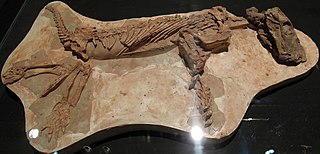
Viatkogorgon is a genus of gorgonopsian that lived during the Permian period in what is now Russia. The first fossil was found at the Kotelnich locality near the Vyatka River and was made the holotype of the new genus and species V. ivachnenkoi in 1999. The generic name refers to the river and the related genus Gorgonops—the gorgons of Greek mythology are often referenced in the names of the group. The specific name honors the paleontologist Mikhail F. Ivakhnenko. The holotype skeleton is one of the most complete gorgonopsian specimens known and includes rarely preserved elements such as gastralia and a sclerotic ring. A larger, but poorly preserved specimen has also been assigned to the species.

Brygmophyseter, known as the biting sperm whale, is an extinct genus of toothed whale in the sperm whale family with one species, B. shigensis. When it was first described in 1994, the species was placed in the genus Scaldicetus based on tooth morphology, but this was later revised in 1995. In 2006, it was classified into the genus Naganocetus, which is considered to be a junior synonym. The only known specimen, a nearly complete skeleton, was dated to be around 16–15 million years old. Brygmophyseter is thought to have been 6.5–7 meters (21–23 ft) long, and it probably had 11 or 12 teeth in the upper and lower jaws. Brygmophyseter is part of a group of macroraptorial sperm whales which tended to be apex predators using their large teeth to catch struggling prey such as whales. It had a spermaceti organ which was probably used for biosonar like in the modern sperm whale. The whale has made an appearance on The History Channel's TV series Jurassic Fight Club.

Georgiacetus is an extinct genus of ancient whale known from the Eocene period of the United States. Fossils are known from Georgia, Alabama, and Mississippi and protocetid fossils from the right time frame, but not yet confirmed as Georgiacetus, have been found in Texas and South Carolina.
Gaviacetus is an extinct archaeocete whale that lived approximately 45 million years ago. Gaviacetus was named for its characteristic narrow rostrum and the fast pursuit predation suggested by its unfused sacral vertebrae.
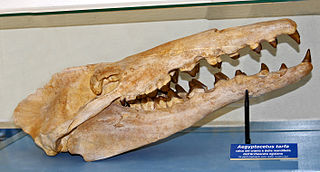
Aegyptocetus is an extinct genus of protocetid archaeocete whale known from Egypt.
Carolinacetus is an extinct protocetid early whale found in the Bartonian Tupelo Bay Formation in Berkeley County, South Carolina.
Eocetus is an extinct protocetid early whale known from the early-late Eocene Giushi Formation in Gebel Mokattam, outside Cairo, Egypt. Fossil remains have also been discovered in the Aridal Formation of the Sahara Desert in southwestern Morocco.

Llanocetus is a genus of extinct toothed baleen whales from the Late Eocene of Antarctica. The type species, Llanocetus denticrenatus, reached gigantic proportions, with the juvenile specimen reaching an estimated 8 m (26 ft) in length; a second, unnamed species, known only from three isolated premolar teeth, reached an estimated total body length of up to 12 m (39 ft). Like other contemporary baleen whales of the Eocene, Llanocetus completely lacked baleen in its jaws. It was probably a suction feeder like the modern beaked and pygmy right whales.
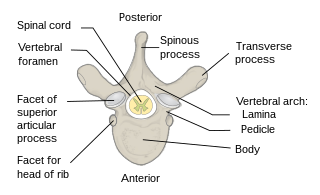
Each vertebra is an irregular bone with a complex structure composed of bone and some hyaline cartilage, that make up the vertebral column or spine, of vertebrates. The proportions of the vertebrae differ according to their spinal segment and the particular species.
Yamatocetus canaliculatus is an extinct species of eomysticetid baleen whale from the Late Oligocene of Japan.
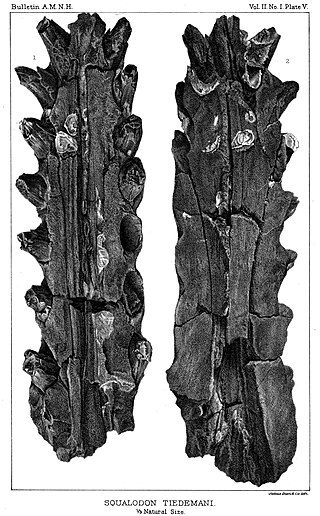
Ankylorhiza is an extinct genus of toothed whale that lived in what is now the United States during the Oligocene epoch, between 29 and 23.5 million years ago. The type and only known species is A. tiedemani, though two fossil skeletons may represent an additional, second species within the genus. Ankylorhiza was about 4.8 meters (16 ft) long, with a long, robust skull bearing conical teeth that were angled forwards at the tip of the snout.

Antaecetus is an extinct genus of pachycetine basilosaurid from the middle Eocene Aridal Formation of Morocco as well as the Fayum, Egypt. Antaecetus, although known from fewer remains in total, is markedly more complete than the closely related Pachycetus, with one specimen preserving large parts of the vertebral column up to the lumbar vertebrae and a well preserved skull. Based on these remains Antaecetus appears to have been smaller than Pachycetus, with a proportionally smaller head and much more gracile teeth. Both genera however share a highly osteosclerotic and pachyostotic skeleton, greatly increasing their weight and possibly serving as additional ballast. In turn the elongation and thickening of the vertebrae severely impacts the animals movement, most likely causing it to have been much slower and far less mobile than other archaeocetes. It has been proposed that Antaecetus was a slow moving inhabitant of shallow coastal waters, where it would ambush fish and marine molluscs. Only a single species of Antaecetus is known, Antaecetus aithai, which was originally described as a species of Pachycetus.















